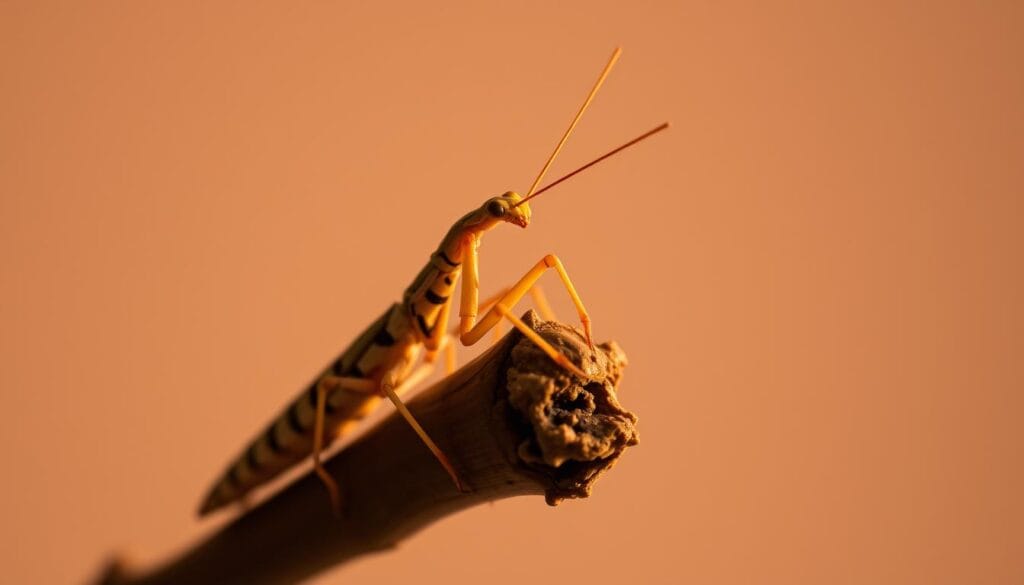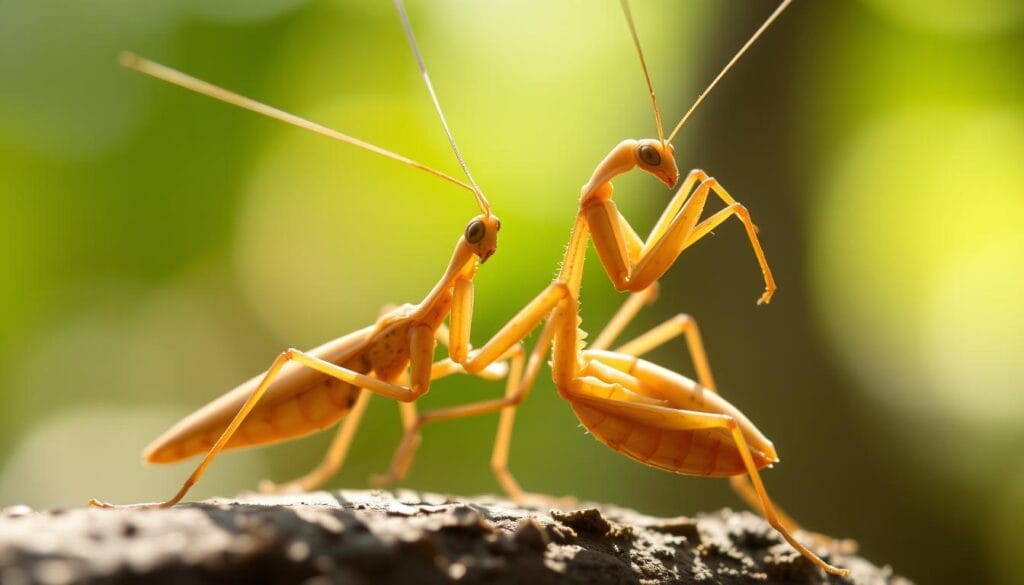Exploring the world of stick insects can change how you see nature’s best camouflages. These amazing creatures offer a special pet experience. It’s about keeping a pet and creating a mini natural world in your home.
There are thousands of stick insect species, but only a few are good pets. The Indian stick insect is a favorite among enthusiasts. These insects blend into their surroundings, making them living art that challenges our view of nature.
Learning about stick insect care routine needs patience and careful attention. These delicate creatures do best in environments that closely match their natural homes. This allows them to show off their amazing camouflage while staying healthy and happy.
Table of Contents
Setting Up the Perfect Habitat for Your Stick Insect
Creating a great home for your stick insect is key to their health and happiness. You need to think about what they need to feel at home. Choosing the right enclosure is very important for their well-being.
Choosing the Right Enclosure
Deciding between glass and plastic enclosures is important. Each has its own benefits for keeping the right temperature and humidity. Exotic pet lovers suggest looking at these points:
- Glass enclosures let you see your pet well
- Plastic containers are light and easy on the wallet
- Good ventilation is key for the right humidity
Size Matters for Stick Insects
The size of the enclosure is crucial for your stick insect’s growth and molting. Experts say a minimum height of 15 inches is best. A 10- or 15-gallon tank is ideal. This gives your stick insect enough room to molt and move around.
Temperature and Humidity Essentials
Keeping the right temperature and humidity is vital. Aim for a temperature of 70 to 75 degrees Fahrenheit and humidity of at least 75%. Here’s how to create the perfect environment:
- Use a small heating pad for a steady temperature
- Regularly mist with a spray bottle
- Check humidity with a hygrometer
Pro tip: Different stick insect species have different needs. So, do your research to care for your specific type best.
Choosing the Right Substrate and Decor
Creating the perfect home for stick insects is all about the right substrate and design. Your care routine should focus on making a cozy, natural space. This space should feel like their home in the wild.
Recommended Substrate Options
Choosing the right substrate is key for keeping the right humidity. It also makes their living space comfy. Here are some top picks for stick insect homes:
- Peat moss: Keeps moisture in
- Vermiculite: Keeps humidity just right
- Coconut fiber: Offers a natural, airy base
- Organic soil mix: Makes the ground feel real
Essential Decor for Enrichment
Adding the right decor is part of good care. It helps them behave naturally and stay happy. Here are some must-haves for their habitat:
- Branches of different sizes
- Dried leaves for hiding
- Small potted plants (safe for them)
- Mesh or cork bark for climbing
Pro tip: Pick decor that lets them hide and feel safe.
The substrate should be about 5 cm deep. This lets them burrow and helps good bacteria grow. When setting up their home, use natural materials to match their wild habitat.
Maintaining Optimal Temperature and Humidity Levels
Creating the perfect environment for your stick insect is key to their survival. Your care routine must focus on precise temperature and humidity control. This ensures your pet thrives in captivity.
Stick insects are sensitive and need specific conditions. The ideal temperature is between 70 to 75 degrees Fahrenheit during the day. At night, it should drop to the mid-60s. Keeping these temperatures helps mimic their natural habitat and supports their health.
Ideal Temperature Ranges for Different Species
- Tropical stick insects: 72-78°F
- Desert-dwelling species: 65-75°F
- Temperate stick insects: 68-72°F
Humidity Control Techniques
Stick insect humidity is also crucial in their care. Most species need humidity levels between 70-80%. You can achieve this in several ways:
- Regular misting of the enclosure
- Using a hygrometer to monitor moisture levels
- Placing a shallow water dish in the habitat
- Selecting moisture-retaining substrate materials
Pro tip: Avoid extreme humidity fluctuations, as they can cause stress and potential health issues for your stick insect.
By managing stick insect temperature and humidity carefully, you’ll create a comfortable environment. This environment supports your pet’s growth, molting, and overall well-being.
Selecting the Best Diet for Your Stick Insect
Creating the right diet for your stick insect is key to their health. Knowing what they need helps you keep them happy and growing. This is important for their well-being.
Stick insects need different foods based on their type. Indian stick insects, for instance, like to eat leaves from many plants:
- Oak leaves
- Rose leaves
- Hawthorn branches
- Blackberry leaves
- Privet
- Ivy
Food Frequency and Portion Control
How often you feed your stick insect depends on their age. Young ones or those that have recently molted need food every day. Adults, on the other hand, can eat less often:
- Young stick insects: Feed daily
- Adult stick insects: 1-3 meals per week
Nutritional Diversity and Safety
Choose fresh, pesticide-free leaves for your stick insect’s diet. Stay away from plants near busy roads or treated with chemicals. A good care routine includes:
- Providing fresh food regularly
- Removing uneaten food to prevent mold
- Offering variety in leaf selection
- Ensuring clean, chemical-free sources
Stick insects also like fruit treats like apples, pears, and bananas. Just make sure to take them away quickly to keep their home clean.
Feeding Guidelines: Frequency and Quantity
Stick insect diet is key to their health and long life. Your care routine must focus on feeding them right. This supports their unique nutritional needs.
Knowing how to feed stick insects is vital for their well-being. These insects need specific foods based on their species and age.
Feeding Frequency for Different Stick Insect Species
- Young stick insects: Need food every day
- Adult stick insects: Can eat every 2-3 days
- Some species may need food more often
Portion Control Strategies
It’s important to avoid overfeeding. Stick insects are natural grazers, but too much food can harm them.
| Insect Size | Recommended Feeding Amount | Frequency |
|---|---|---|
| Juvenile Stick Insects | Small, fresh leaf clusters | Daily |
| Adult Stick Insects | Moderate leaf portions | Every 2-3 days |
Use narrow-necked water containers for fresh branches. This keeps food fresh and prevents drowning. Change leaves often to keep them fresh and prevent mold.
Pro tip: Watch how your stick insect eats and adjust food amounts. Each species has its own food preferences.
Keep an eye on how much food your stick insect eats. This helps you tailor their diet for their health and growth. Always use fresh, pesticide-free leaves for their nutrition.
Understanding Lighting Needs for Your Insect

Lighting is very important in caring for your stick insect. These creatures have special needs that are different from most pets. Knowing what they need for lighting helps you make a great home for them.
Natural vs. Artificial Lighting Considerations
Stick insects are mostly active at night. So, when setting up their home, you should follow their natural light cycle:
- Provide a day/night cycle of 10-12 hours
- Use soft, indirect natural light when possible
- Avoid bright white lights that can stress the insects
Daylight Cycling Best Practices
Managing light is crucial for your stick insect’s health. Here are some important tips:
- Use red or infrared bulbs for nighttime observation
- Position the enclosure to receive gentle, indirect sunlight
- Implement a timer to regulate light exposure
Remember, being consistent with light is important. A steady light cycle helps keep their natural rhythms. It also supports their overall health.
Routine Health Checks and Hygiene
Keeping your stick insect healthy is key. They need a little care but regular checks to stay well. Handling them gently is important.
Spotting Common Health Issues
Watch for health signs when you handle your stick insect. Look out for:
- Unusual lethargy or immobility
- Discoloration of exoskeleton
- Difficulty molting
- Visible mold or fungus on body
Check your stick insect often. Experts say to do this at least twice a week. This helps spot problems early.
Enclosure Cleaning Guidelines
A clean home is vital for your stick insect. Follow these steps for a clean habitat:
| Cleaning Task | Frequency | Method |
|---|---|---|
| Remove dead leaves | Weekly | Gentle removal with tweezers |
| Substrate replacement | Monthly | Complete substrate change |
| Disinfect enclosure | Every 2-3 months | Use reptile-safe disinfectant |
Pro tip: Keep your hands clean when handling stick insects. This helps avoid stress and contamination.
Breeding Stick Insects: What You Need to Know

Stick insect breeding is an exciting journey for those who love these creatures. It’s important to know how to care for them to have a successful breeding process and a healthy population.
To breed stick insects, you need to prepare carefully and create the right environment. Each species has its own needs, but there are some general tips to follow.
Conditions Necessary for Breeding
To breed stick insects successfully, you must create the best living conditions:
- Keep the temperature between 70-75 degrees Fahrenheit
- Ensure humidity is at least 75%
- Provide enough vertical space in their enclosures
- Make sure breeding adults have the right food
Caring for Hatchlings
Stick insect hatchlings are very delicate and need special care. Their survival depends on precise environmental management. Young stick insects require:
- Gentle handling to avoid injuries
- Appropriate sized enclosures
- Soft, moist substrate
- A diet that matches their small size
Some species breed fast, which can lead to population management issues. You must be ready to manage your stick insect colony responsibly to avoid ecological risks.
Pro tip: Always research specific breeding requirements for your particular stick insect species to maximize success.
Fun Facts About Stick Insect care routine
Stick insects are truly fascinating, with over 3,000 species worldwide. They can hide in plain sight, thanks to their amazing camouflage. These insects are part of the 70% of animal species that are insects, playing a key role in keeping ecosystems balanced.
Learning about stick insect care can be fun. Each species, from tiny leaf-mimics to large walking sticks, has unique traits. Some can even grow back lost limbs, and others have clever ways to defend themselves.
Interesting Species to Explore
The stick insect world is incredibly varied. The Lord Howe phasmid, thought lost, was rediscovered in 2001. Since then, nearly 19,000 of these insects have been bred in just 16 generations. These stories show how important it is to care for and conserve stick insects.
The Role of Stick Insects in Ecosystems
Stick insects are more than just interesting to look at. They are crucial to their ecosystems as both herbivores and prey. Like other insects that help agriculture, they remind us of the vital role small creatures play in keeping our world healthy and diverse.

